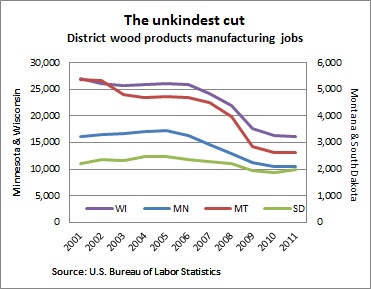There’s good news for the Ninth District’s wood products industry: After years of retrenchment caused by the housing collapse and subsequent recession, the bleeding appears to have stopped.
Sawmills and manufacturers have reported increased output and revenues this year as the U.S. economy slowly improves, increasing demand for construction lumber and other wood products. After bottoming out in 2010, industry employment in Minnesota, Wisconsin, South Dakota and Montana rose slightly last year, according to government labor figures (see chart).

The bad news is that the industry has a way to go to recover thousands of jobs lost over the past decade. Montana saw the steepest drop in wood manufacturing jobs; employment fell by more than half between 2001 and 2010. The state’s sawmills were already in decline before the housing crisis, due to rising operating costs and log prices.
Employment in Minnesota and Wisconsin followed a similar downward path after the housing crash as demand sagged for oriented strand board, paperboard and office paper. Wood products workers in South Dakota fared better; during the housing downturn, many firms shifted their focus to the home remodeling market, shoring up sales and preserving jobs. But wood products manufacturers in the state still shed about 250 jobs over the past decade.
It’s questionable whether wood products employment will ever return to the levels seen at the height of the housing boom. In recent years, rising productivity has reduced the number of workers needed to run sawmills, paper mills, particle board plants and other forest products operations. Neiman Enterprises, a large sawmill operation in the Black Hills of South Dakota, has ramped up its lumber production since 2010. But over the same period, investments in automation have allowed the firm to reduce its headcount, said resource manager Dan Buehler.
And in western Montana and the Black Hills, a persistent infestation of mountain pine bark beetles has killed millions of pine trees, threatening to restrict future log supplies. (For much more on the impact of the pine beetle outbreak on the wood products industry, watch the fedgazette website for the upcoming article, “The beetle and the damage done.”)
Research Assistant Dulguun Batbold contributed to this Roundup post.





